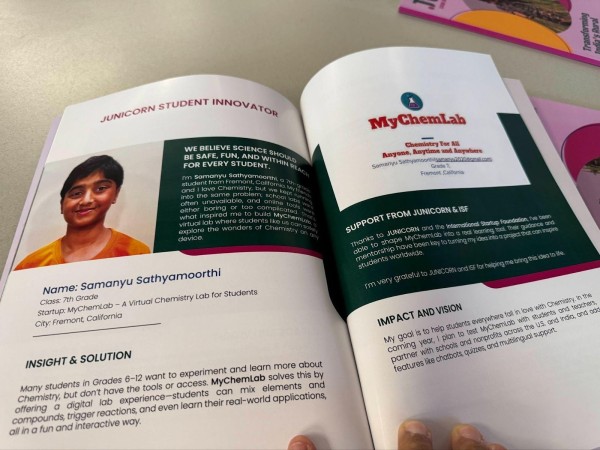Press Release
EMMY Winner Jen Greenstreet and Peabody Winner Jason Loftus premiere at New Media Film Festival Los Angeles
The highly anticipated 16th season of the New Media Film Festival® is set to dazzle audiences on June 4-5, 2025, in Los Angeles, California, with a groundbreaking lineup of 80 films and tech content that span genres, styles, and mediums. 55 Nominees from 14 countries including USA, UK, South Korea, Netherlands, Ireland, Hong Kong, Germany, France, Denmark, Canada, Bulgaria, Brazil, Australia, Argentina.
Los Angeles: The highly anticipated 16th season of the New Media Film Festival® is set to dazzle audiences on June 4-5, 2025, in Los Angeles, California, with a groundbreaking lineup of 80 films and tech content that span genres, styles, and mediums. 55 Nominees from 14 countries including USA, UK, South Korea, Netherlands, Ireland, Hong Kong, Germany, France, Denmark, Canada, Bulgaria, Brazil, Australia, Argentina. Full details at www.newmediafilmfestival.com/events
Among the standout entries are two exceptional titles that promise to captivate and inspire:

An essential, powerful exploration of the growing food allergy crisis, May Contain: Danger brings to light the life-or-death urgency of normalizing food allergies. This compelling film not only delves into the difficult choice between staying alive and fitting in but also unveils a blueprint for living life to the fullest while navigating these challenges. Created by EMMY winner Jen Greenstreet, the film offers a moving and relatable narrative that resonates with people from all walks of life.

Dive into the fractured, otherworldly realm of numen9, where oceans float above the sky and conflict looms between two powerful factions. In the midst of this looming turmoil, teenage twins Atla and Kryll revel in the limelight, embarking on a secret mission disguised as a celebrity appearance. Accompanied by Yana, Atla’s best friend and numen9’s biggest pop star, their journey takes a dangerous twist when a rebel’s interference forces Atla to take center stage. From the visionary mind of Peabody winner Jason Loftus, Sky of Tides: Atla masterfully blends adventure, intrigue, and a vibrant sci-fi setting into an unforgettable cinematic experience.
Explore Cutting-Edge Storytelling at the 16th Annual New Media Film Festival®

Get ready to immerse yourself in a celebration of innovation and creativity at the 16th season of the New Media Film Festival®, taking place June 4-5, 2025, from Los Angeles, California. This groundbreaking event offers a dynamic lineup of thought-provoking documentaries, feature films, music videos, AI-generated content, and more—spanning themes like faith, spirituality, and thrilling genre storytelling.
With $45,000 in awards at stake, including Best of Category, Top 3 Scripts, and the Grand Prize, the festival honors creators of all ages, cultures, and media who craft stories worth telling. This is more than a showcase—it’s a celebration of excellence and innovation, uniting a global community of visionary storytellers and audiences.
The New Media Film Festival® continues to solidify its reputation as a premier platform for groundbreaking storytelling, technology, and talent. Don’t miss your chance to be part of this one-of-a-kind event. Whether attending in person or online, this year’s festival promises an experience that pushes the boundaries of creativity and offers unparalleled opportunities to engage with visionary content.
Visit www.newmediafilmfestival.com to learn more about the lineup and secure your spot for this unforgettable event. Step into the future of storytelling with the New Media Film Festival®—where innovation takes center stage.
About Author
Disclaimer: The views, suggestions, and opinions expressed here are the sole responsibility of the experts. No Digi Observer journalist was involved in the writing and production of this article.
Press Release
COOFANDY & Christopher Bell: Dressing the Journey to Victory – A Partnership Story Racing Toward Martinsville Speedway

The partnership between COOFANDY and Joe Gibbs Racing (JGR) alongside their driver Christopher Bell, established earlier this year, has been a dynamic fusion of high-speed motorsport and sophisticated style. As COOFANDY prepares to sponsor the event at Martinsville Speedway on October 26, 2025, let’s revisit the key moments of this thrilling collaboration.
Partnership Journey Recap
May: The Collaboration Begins
During its 10th-anniversary celebrations, COOFANDY officially announced Christopher Bell as its global brand ambassador. The launch also featured the debut of the “Bell’s Picks” product collection and a creative comic series.

June: Father’s Day Special Event
COOFANDY organized a special fan viewing experience during the FireKeepers Casino 400 in Michigan, blending COOFANDY fans with the NASCAR community to celebrate Father’s Day together.
July: Online Interaction & JGR Headquarters Experience
Christopher Bell made a surprise appearance in COOFANDY’s New York live stream, recommending his favorite styles. Subsequently, the brand hosted the “Approaching the Legend Journey,” inviting influencers and fans for an exclusive behind-the-scenes tour of the legendary Joe Gibbs Racing headquarters.

Next Stop: Martinsville – A Crucial Battle in the NASCAR PlayoffsThe partnership is accelerating towards its next highlight: the Xfinity 500 at Martinsville Speedway on October 26, 2025. This is not just another race on the calendar; it’s a critical elimination event in the NASCAR Playoffs Round of 8, where championship hopes are forged or shattered. COOFANDY’s sponsorship of Christopher Bell’s No. 20 Toyota at this pivotal moment underscores COOFANDY’s pursuit of excellence and peak performance. It places COOFANDY at the heart of the action, connecting with millions of passionate fans worldwide during one of the season’s most intense and watched races.
Track Aesthetics: COOFANDY Exclusive Designs Debut
For this landmark race, COOFANDY’s brand identity will be prominently displayed through custom-designed assets that bridge fashion and function:
Car Livery: The No. 20 Toyota will feature a unique livery incorporating COOFANDY’s brand elements. The design seamlessly integrates the brand’s visual identity with dynamic racing aesthetics, using a combination of the brand’s signature colors and sleek graphics that embody both speed and sophistication. The livery is designed to stand out under the track lights, ensuring high visibility and a powerful brand statement.

Firesuit: Christopher Bell will wear a specially designed firesuit featuring COOFANDY’s brand elements and logos. Beyond brand display, this suit reflects a balance of the brand’s elegant style and the rigorous technical demands of a professional driver.

Beyond the Track: COOFANDY’s New Chapter in Sports Marketing
The collaboration with NASCAR and a top-tier driver like Christopher Bell is a strategic cornerstone for COOFANDY’s global marketing expansion. This move leverages NASCAR’s immense popularity and emotional connection to authentically engage with a vast and loyal audience. It interprets COOFANDY’s “Dress the Journey” philosophy in a high-performance environment, linking the brand with values of excellence, precision, and the pursuit of victory. This partnership serves as a powerful engine for enhancing international brand awareness and connecting with new consumers who share a passion for sports and lifestyle.
Conclusion
COOFANDY sincerely thanks all fans for their support throughout this partnership. Don’t miss the next chapter: watch Christopher Bell drive the COOFANDY-branded car at Martinsville Speedway on October 26th. Stay tuned for more updates.
For more information, please visit the COOFANDY website and Amazon storefront, or connect with COOFANDY on Facebook and Instagram.
COOFANDY
Charlotte Liu
New York, US
About Author
Disclaimer: The views, suggestions, and opinions expressed here are the sole responsibility of the experts. No Digi Observer journalist was involved in the writing and production of this article.
Press Release
A New Era in the Crypto Market ETH Volume Bot Redefines Success for Token Projects
The Ethereum ecosystem continues to evolve rapidly, with new token projects emerging every day. For many developers, maintaining transparent, consistent, and data-driven liquidity management on decentralized exchanges (DEXs) remains one of the biggest challenges. ETH Volume Bot, a blockchain automation platform, aims to support these needs by offering analytical and operational tools that help projects monitor, manage, and automate their on-chain trading activity in a secure and compliant way.

A Technology-Driven Approach to On-Chain Activity
ethvolumebot.com provides automated infrastructure to assist token teams in managing liquidity, transaction execution, and on-chain analytics on Ethereum-based DEXs. The platform leverages automation to improve transaction efficiency and to help projects better understand their market presence through advanced data insights.
Since its introduction, the system has been utilized by numerous Ethereum-based initiatives to streamline operational processes and optimize smart contract interactions within transparent and regulated frameworks.
Introducing the Batch Transaction Queue (BTQ)
One of ETH Volume Bot’s key innovations is the Batch Transaction Queue (BTQ) — a mechanism designed to optimize transaction efficiency and reduce gas expenditure on the Ethereum network.
BTQ enables multiple small transactions to be processed in a bundled and gas-efficient manner, helping project teams lower operational costs while maintaining transaction transparency and traceability on-chain.
This technology contributes to a more efficient use of network resources, minimizing redundant transactions and improving on-chain data consistency. By reducing gas costs, BTQ enhances accessibility for smaller or early-stage blockchain projects.
Advanced Controls and Analytics
The platform’s automation framework allows project teams to define operational parameters with precision, while the real-time analytics dashboard provides comprehensive visibility into performance metrics.
Teams can track liquidity distribution, trading patterns, and historical data, enabling informed, evidence-based decision-making.
The system integrates seamlessly with leading decentralized exchanges such as Uniswap, SushiSwap, and 1inch, ensuring compatibility with Ethereum-standard liquidity environments.
Security and Non-Custodial Design
Security and control remain top priorities. ETH Volume Bot follows a 100% non-custodial architecture, meaning users maintain full ownership and access to their assets at all times.
All operations are executed directly through Web3 wallets such as MetaMask or WalletConnect, ensuring that no funds are ever transferred to third-party custody.
The platform’s smart contracts have undergone independent security audits, validating their reliability and operational safety.
Transparency and Compliance
ETH Volume Bot emphasizes transparency, auditability, and compliance as fundamental principles of its design.
All on-chain activities are publicly verifiable, and the system operates strictly as a technological and analytical tool — not a financial advisory or promotional mechanism. Its purpose is to empower blockchain projects to manage their operations responsibly and within ethical standards.
About ETH Volume Bot
ETH Volume Bot is a blockchain automation and analytics platform that helps token projects manage transaction efficiency, liquidity operations, and smart contract activity across decentralized exchanges.
The system’s modular infrastructure is built for transparency, security, and operational scalability within the Ethereum ecosystem.
Official website: https://www.ethvolumebot.com
Media Contact
Organization: ETH Volume Bot
Contact Person: Aglae Bergnaum
Website: https://www.ethvolumebot.com
Email: Send Email
Country:United States
Release id:35647
The post A New Era in the Crypto Market ETH Volume Bot Redefines Success for Token Projects appeared first on King Newswire. This content is provided by a third-party source.. King Newswire makes no warranties or representations in connection with it. King Newswire is a press release distribution agency and does not endorse or verify the claims made in this release. If you have any complaints or copyright concerns related to this article, please contact the company listed in the ‘Media Contact’ section
About Author
Disclaimer: The views, suggestions, and opinions expressed here are the sole responsibility of the experts. No Digi Observer journalist was involved in the writing and production of this article.
Press Release
13-Year-Old Samanyu Sathyamoorthi Wins Curiosity Innovation Award at Global AI Summit with MyChemLab-ai Aiming to Solve Worldwide Chemistry Lab Access Crisis
Innovative Virtual Chemistry Platform Leverages Google’s Gemini AI to Create Accessible, Risk-Free STEM Learning for Millions of Students Lacking Hands-On Experience.
United States, 18th Oct 2025 – Samanyu Sathyamoorthi, a 13-year-old innovator, 8th-grade student at John M. Horner Middle School in Fremont, CA, and future attendee of Iron Horse Middle School in San Ramon, CA, has been recognized on the global stage for his pioneering work in educational technology.
Samanyu won the prestigious Achievement: Curiosity/Innovation Award at the ISF Global Junicorn & AI Summit 2025. A student-focused innovation event that took place on May 29-30, 2025 at Texas State University in San Marcos, Texas, convened the world’s most promising student innovators, known as “Junicorns,” to present how they are using cutting-edge AI and technology to solve significant, real-world problems. Samanyu’s platform, MyChemLab.ai, stood out for its profound potential to democratize science education globally.

Photo: (Image of Samanyu Sathyamoorthi receiving his Innovation Award for his project at the summit — MyChemLab.ai at the ISF Global Junicorn & AI Summit 2025, Texas State University, TX.”)
Disrupting the Chemistry Education Gap with AI
MyChemLab.aiis a revolutionary AI-powered virtual chemistry laboratory honored for its mission to make science education more accessible, interactive, and equitable worldwide. The platform’s creation is a direct response to a critical global crisis: the lack of functioning, hands-on chemistry laboratories.
According to research cited by Samanyu, an estimated 15 million students in the U.S. and 75 million students in India—a population equivalent to the combined populations of New York and California—lack the necessary infrastructure for practical, hands-on chemistry experience. This systemic deficit, particularly for students in grades 6 through 12, severely limits opportunities for experimentation, diminishes scientific curiosity, and curtails pathways into vital STEM careers.
“MyChemLab aims to tear down traditional barriers to science education and create equity,” explains Samanyu. “By providing an immersive, risk-free platform accessible on any device, students can experiment with elements and observe reactions that would typically require expensive, dangerous, or unavailable real-world equipment. It’s about making chemistry fun and accessible for every student, anytime and anywhere.”
Technical Depth and The Gemini AI Core
The effectiveness of MyChemLab.ai lies in its sophisticated technical architecture and the intelligent simulation engine at its core. Built on a modern full-stack foundation utilizing React.js for a dynamic front-end and Node.js for the back-end, the application secures student data and class progress via Firebase.
The platform’s core innovation is its deep integration with the Gemini AI Platform. The AI functions as a dynamic reaction engine, simulating complex chemical interactions with realistic fidelity. This capability allows students to manipulate environmental variables—including adjustable Pressure, Temperature, and Reaction Time controls—to observe cause-and-effect in real-time, replicating the unpredictability and rigor of a physical lab without any associated risk or cost.
Key features driving this educational depth include:
- A comprehensive chemical database containing over 115 elements and 30 compounds.
- Realistic outcome modeling via the Gemini AI Platform.
- Separate teacher and student portals designed to seamlessly integrate into classroom curricula, enabling assignments, collaborative learning, and standardized assessments.
The project is already demonstrating tangible impact, currently serving 40 active users and undergoing live testing in classrooms across the U.S. and India.

Photo: (Image of Samanyu Sathyamoorthi with his project at the summit — presenting MyChemLab.ai at the ISF Global Junicorn & AI Summit 2025, Texas State University, Austin, TX.”)
Validation and Educational Impact
The project has garnered significant praise from both the technical and educational communities, validating its promise as a transformative learning tool.
“It’s truly impressive to see someone your age harness AI for such a complex subject like chemistry,” said Dr. Sumathy Kumar, Ph.D., Chemistry Educator in India. “Projects like yours show us the incredible potential of young minds and remind us that the future of science is bright.”
Mitran, Director of Marketing at the ISF Global Summit, echoed this sentiment, adding, “I’m really impressed with the depth you’ve covered—from the secure login flow to the way you’ve integrated interactive sliders for variable manipulation. This is professional-grade application development.”
Educators have been instrumental in guiding the platform’s development. Ms. Corine Benedetti, a FUSD Teacher, provided constructive input, noting, “As someone with limited experience in chemistry, I think it could be very helpful to have a tutorial or suggested experiment section. That feedback will definitely help guide its next phase of development.” This practical feedback confirms MyChemLab.ai’s relevance and accessibility for a broad range of student and educator proficiency levels.

Photo: (Insert image of MyChemLab – “A screenshot of MyChemLab’s virtual experiment interface, featuring sliders for temperature, pressure, and time.”)
Next Steps and Expanding the Vision
Following his success at the ISF Summit, Samanyu is preparing to submit MyChemLab.ai to the prestigious 2025 Congressional App Challenge, which celebrates student innovation in computer science. His goal is to represent his schools and community at the national level, continuing to showcase how technology can equalize learning opportunities. He will be representing California’s 10th Congressional District (Rep. Mark DeSaulnier) from Iron Horse Middle School in San Ramon.
Looking ahead, Samanyu plans to dramatically enhance the platform’s pedagogical power:
- Integrating a built-in, real-time AI chatbot tutor that explains complex chemical principles and provides academic assistance.
- Introducing advanced Augmented Reality (AR) and Virtual Reality (VR) experiences for truly immersive experimentation.
- Adding gamification elements like badges and leaderboards to boost long-term student engagement and interest.
“Winning this award motivates me to keep building tools that make science accessible,” Samanyu shared. “I want every student, no matter where they are, to have the chance to explore the magic of chemistry.”
About ISF Global Junicorn & AI Summit
The Innovation STEM Foundation (ISF) hosts the Global Junicorn & AI Summit annually to inspire and recognize young innovators in AI, robotics, and sustainability. The 2025 event featured over 300 student innovators from 10+ countries, with judging panels comprised of academic and technology leaders.
Media Contact
Rocky Zester
crazyme2207@gmail.com
Project Website: www.mychemlab.ai
Student Innovation Channel:
https://www.youtube.com/channel/UCJ6UEab559ioCDRZ7LH_6sw/
Fremont & San Ramon, California
Media Contact
Organization: Silicon Stem
Contact Person: Rocky Zester
Website: https://www.mychemlab.ai/
Email: Send Email
Country:United States
Release id:35641
The post 13-Year-Old Samanyu Sathyamoorthi Wins Curiosity Innovation Award at Global AI Summit with MyChemLab-ai Aiming to Solve Worldwide Chemistry Lab Access Crisis appeared first on King Newswire. This content is provided by a third-party source.. King Newswire makes no warranties or representations in connection with it. King Newswire is a press release distribution agency and does not endorse or verify the claims made in this release. If you have any complaints or copyright concerns related to this article, please contact the company listed in the ‘Media Contact’ section
About Author
Disclaimer: The views, suggestions, and opinions expressed here are the sole responsibility of the experts. No Digi Observer journalist was involved in the writing and production of this article.
-
Press Release1 day ago
Futuromining Launches XRP Mining Contracts – XRP Holders Earn $5,777 Daily
-
Press Release1 week ago
Dream California Getaway Names Bestselling Author & Fighting Entrepreneur Tony Deoleo Official Spokesperson Unveils Menifee Luxury Retreat
-
Press Release6 days ago
Pool Cover Celebrates Over 10 Years of Service in Potchefstroom as Swimming Pool Cover Market Grows Four Point Nine Percent Annually
-
Press Release1 day ago
13-Year-Old Samanyu Sathyamoorthi Wins Curiosity Innovation Award at Global AI Summit with MyChemLab-ai Aiming to Solve Worldwide Chemistry Lab Access Crisis
-
Press Release5 days ago
Weightloss Clinic Near Me Online Directory USA Launches Nationwide Platform to Help Americans Find Trusted Weight Loss Clinics
-
Press Release1 week ago
James Jara New Book Empowers CTOs and HR Leaders to Build High-Performing Remote Teams Across Latin America
-
Press Release1 week ago
Beyond Keyboards and Mice: ProtoArc Shines at IFA 2025 with Full Ergonomic Ecosystem
-
Press Release4 days ago
La Maisonaire Redefines Luxury Furniture in Dubai with Bespoke Designs for Homes Offices and Hotels



